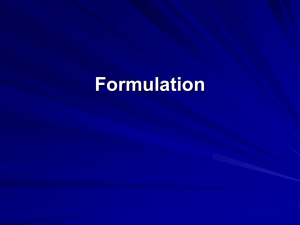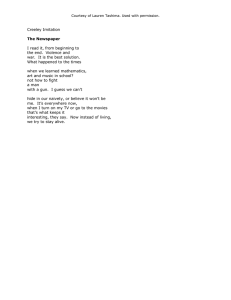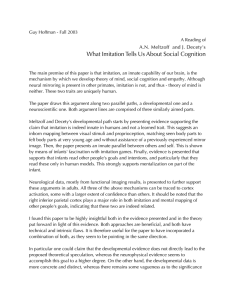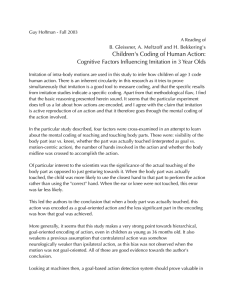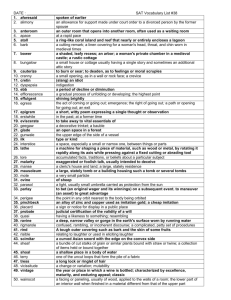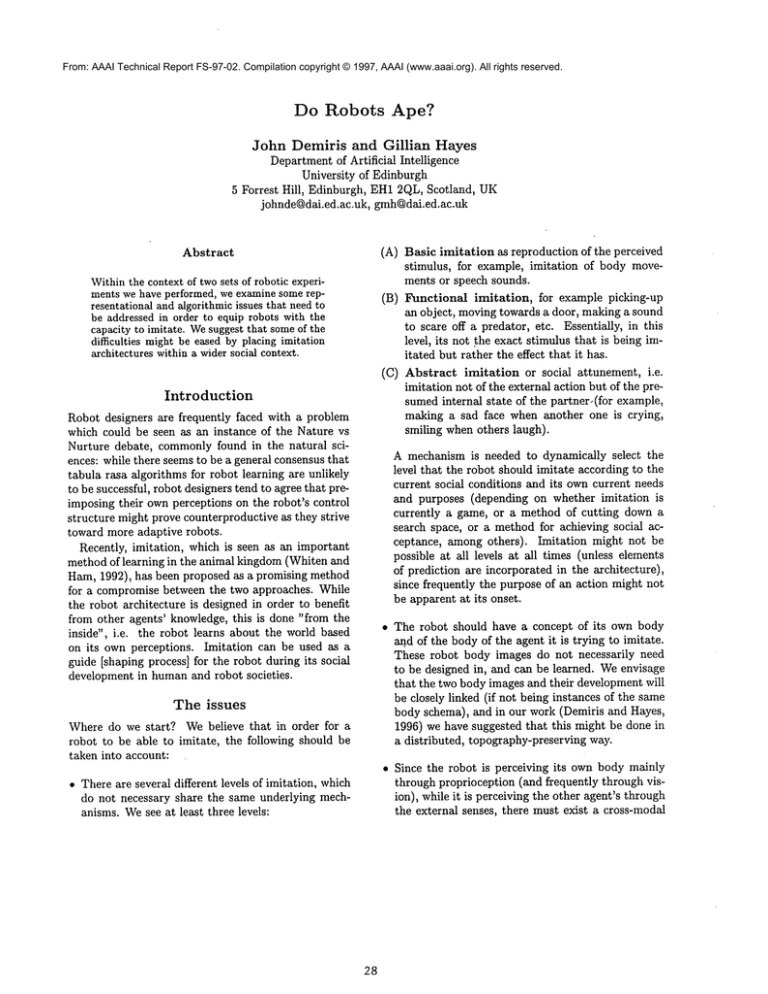
From: AAAI Technical Report FS-97-02. Compilation copyright © 1997, AAAI (www.aaai.org). All rights reserved.
Do Robots
Ape?
John Demiris and Gillian
Hayes
Departmentof Artificial Intelligence
University of Edinburgh
5 Forrest Hill, Edinburgh, EH12QL, Scotland, UK
johnde@dai.ed.ac.uk, gmh@dai.ed.ac.uk
(A) Basic imitation as reproduction of the perceived
stimulus, for example, imitation of body movements or speech sounds.
(B) Functional imitation, for example picking-up
an object, movingtowards a door, makinga sound
to scare off a predator, etc. Essentially, in this
level, its not the exact stimulus that is being imitated but rather the effect that it has.
(C) Abstract imitation or social attunement, i.e.
imitation not of the external action but of the presumedinternal state of the partner~(for example,
making a sad face when another one is crying,
smiling when others laugh).
Abstract
Withinthe context of twosets of robotic experiments we have performed, we examinesomerepresentational and algorithmicissues that needto
be addressed in order to equip robots with the
capacity to imitate. Wesuggest that someof the
difficulties mightbe eased by placing imitation
architectures within a widersocial context.
Introduction
Robot designers are frequently faced with a problem
which could be seen as an instance of the Nature vs
Nurture debate, commonlyfound in the natural sciences: while there seemsto be a general consensus that
tabula rasa algorithms for robot learning are unlikely
to be successful, robot designers tend to agree that preimposing their ownperceptions on the robot’s control
structure might prove counterproductive as they strive
toward more adaptive robots.
Recently, imitation, which is seen as an important
methodof learning in the animal kingdom(Whiten and
Ham,1992), has been proposed as a promising method
for a compromisebetween the two approaches. While
the robot architecture is designed in order to benefit
from other agents’ knowledge, this is done "from the
inside", i.e. the robot learns about the world based
on its own perceptions. Imitation can be used as a
guide [shaping process] for the robot during its social
development in humanand robot societies.
A mechanism is needed to dynamically select the
level that the robot should imitate according to the
current social conditions and its owncurrent needs
and purposes (depending on whether imitation is
currently a game, or a method of cutting down a
search space, or a methodfor achieving social acceptance, among others). Imitation might not be
possible at all levels at all times (unless elements
of prediction are incorporated in the architecture),
since frequently the purpose of an action might not
be apparent at its onset.
¯ The robot should have a concept of its own body
and of the body of the agent it is trying to imitate.
These robot body images do not necessarily need
to be designed in, and can be learned. Weenvisage
that the two body images and their developmentwill
be closely linked (if not being instances of the same
body schema), and in our work (Demiris and Hayes,
1996) we have suggested that this might be done in
a distributed, topography-preserving way.
The issues
Where do we start? Webelieve that in order for a
robot to be able to imitate, the following should be
taken into account:
¯ Since the robot is perceiving its own body mainly
through proprioception (and frequently through vision), while it is perceiving the other agent’s through
the external senses, there must exist a cross-modal
¯ There are several different levels of imitation, which
do not necessary share the same underlying mechanisms. Wesee at least three levels:
28
matching mechanism that will perceive equivalences between the two modalities, and can translate
between the two.
the robot controller designer is facing. However,the
study of imitation in natural systems is helping to resolve someof the difficulties, by suggesting that the
generative system is actively involved in the recognition process. For example, recent neurophysiological
research (Rizzollati et al, 1996) has indicated a strong
link between the recognition and generation processes,
at the neuronal level, through the discovery of ’mirror’
neurons in the premotor cortex of monkeys, which are
activated both during perceiving and executing certain actions. That meansthat the imitator’s previous
bodily experience influences the way it perceives the
demonstrator’s actions. Apart from reiterating the fact
that past knowledgeinfluences the waythat current information is processed, this work emphasizesthe role
of embodimentin the way cognitive processes operate
(Dautenhahn, 1997; Mataric, 1996).
¯ There are two different forms of learning associated with imitation: learning to imitate and learning
through imitation. In the former, the robot learns
what its motor system has to do in order to do what
the other agent is doing. In the latter, the robot
learns by imitating the other agent, and associating
perceptual experiences (environmental ones, and/or
ownones, such as emotions, biological feedback from
its ownorganism, amongothers) with this motor act.
Robot
Imitation
Examples
Wehave performed two series of robot imitation experiments. One of them was performed on testbeds
involving different types of robot heads and a human
demonstrator (Demiris and Hayes, 1996; Demiris et al,
1997), where the experiments were aimed at examining
the issues involved in movementimitation. The other
series (Hayes and Demiris, 1994) involved two mobile
robots of different morphology,where the experiments
were aimedat examiningthe issues involved in learning
through movementimitation.
Movement Imitation
Weare interested in understanding the mechanisms
underlying imitation of movementsin 3D space, so
we engaged in a series of experiments involving a robot head imitating the head movements of a human
demonstrator. The demonstrator performs a series of
head movementspositioned within the visual field of
the robot head, and the robot imitates these movements. The technical details of these experiments are
described in (Demiris and Hayes, 1996; Demiris et al,
1997); here we will focus on an issue particularly relevant to our discussion: due to the experimental scenario used, there will be different modalities involved
during the perception and the execution of a movement pattern (the visual modality during perception
and the proprioceptive modality during execution).
This points out the necessity of designing a mechanism for bridging the two. In humans, such mechanisms
have been hypothesised to exist at birth (Meltzoff and
Moore,1989), although several questions regarding the
specifics of such mechanismsremain unresolved. For
example, is the information derived from one modality
transferred to the other one directly or is it stored in
some intermediate a-modal representation? The segmentation of the input data (including the selection
of the level to imitate, mentionedearlier, which has
a strong influence on howthe incoming data will be
segmented) is one of the most difficult problems that
29
Learning through Movement Imitation
In this series of experiments, the purpose was to investigate howa robot can learn to negotiate the different types of corners in order to navigate through
a maze. While one agent is knowledgeable about the
task, the other is not, and is only equipped with the
ability to imitate (follow) the first agent. The agents
are placed in a maze, the first agent traverses the maze,
and the second one follows right behind, associating
the environmental states with the motor actions it is
performing due to its imitation of the teacher. We
will focus on a couple of important issues which are
relevant to our discussion here that were made evident during this work(interested readers are referred to
(Hayes and Demiris, 1994) for the details). These
essentially linked with the temporal dimension of the
task. The first one of them is when to imitate: it is
important for the imitator not to imitate the actions
of the demonstrator(such as turning left or right in
corner) immediately, but rather whenthe imitator actually reaches that corner. The answerto this question
might be task-specific, which implies that the imitator
has to have some knowledgeof the task in hand. The
second one is whento associate what you perceive with
what you do. Although some aspects of the answer to
this are also task-specific, a partial solution might be
given through the use of ’novelty detectors’, whichlink
the current action with previous knowledgethat the
imitator might have.
Supporting
the Imitation
Process
Imitation is rarely a uni-directional activity, nor occurs in the absence of other learning processes. Infants and youngchildren, not only imitate their parents
and other peers, but are frequently imitated by them
(Meltzoff, 1996), often engaging in mutual imitation
games. There is also a close link between imitation,
communication and cooperation (Klingspor, Demiris,
and Kaiser, 1997): not only imitation can be used as
a good way of developing communication(Billard and
Hayes, 1997), and equipping the imitator with enough
knowledge about a task so it can eventually engage
in cooperation with other agents, but, reversely, communication can also help in the imitation process by
influencing the waythat the imitator understands the
task in hand, so an appropriate level of imitation can
be selected. For example, the imitator’s action can be
monitored by the demonstrator whocan give feedback
to the imitator on the quality of the imitation (providing the imitator with opportunities to learn howto
imitate), but also on two crucial aspects mentioned
above, whento imitate, and whento associate.
Learning by imitation is frequently combinedwith
other learning processes, in which case the imitation
process can help speeding them (e.g. (Schaal, to appear)). In addition, as we frequently mentionedin this
paper, the imitator’s ownknowledgeand capabilities,
partially obtained by processes other than imitation
(including trial and error learning), influence (hopefully facilitate) the waythat the imitation process will
take place.
These suggest that placing imitation architectures
within a wider social learning context might help us
solve someof the difficult issues in robot imitation that
we outlined in this paper. If we want our robots to
achieve the degree of imitation displayed in natural societies, we have to provide the robots with comparable
levels of social support.
the 5th European Workshop on Learning Robots, V.
Klingspor(ed.), Bari, Italy, July 1996.
Demiris, J.; Rougeaux, S.; Hayes G.; Berthouze L.;
Kuniyoshi, Y., 1997. Deferred Imitation of Human
Head Movementsby an Active Stereo Vision Head. In
Proc. of the 1997 IEEE Workshop on Robot-Human
Communication,Sendai, Japan, Sept. 1997.
Hayes, G.M., and Demiris J., 1994. A Robot Controller Using Learning by Imitation. In Proc. of the 2nd
International Symposiumon Intelligent Robotic Systems, Grenoble, France, July 1994.
Klingspor V., Demiris J., and Kaiser M., 1997.
Human-Robot-Communicationand Machine Learning.
In Applied Artificial Intelligence Journal, Vol. 11, to
appear (1997).
Mataric M.J., 1997. Studying the Role of Embodiment
in Cognition. In Cybernetics and Systems Vol. 28, No.
6, special issue on Epistemological Aspects of Embodied AI, Erich Prem, ed., July 1997.
Meltzoff, A.N., 1996. The HumanInfant as Imitative
Generalist: A 20-Year Progress Report on Infant Imitation with Implications for ComparativePsychology.
In Social Learning in Animals: The Roots of Culture,
Heyes C.M. and Galef B.G. (eds), NewYork: Academic Press.
Meltzoff A.N., and Moore M.K., 1989. Imitation in
Newborn Infants: Exploring the Range of Gestures
Imitated and the Underlying Mechanisms. In Developmental Psychology, 25:6, pp. 954-962.
Acknowledgements
J Demiris is supported by a European Science Foundation fellowship in the program "Learning in Humans
and Machines - TF5: Collab. Learning". Thanks to A
Billard and J Wyatt for their commentson this paper.
Rizzolatti G.; Fadiga L.; Gallese V.; Fogassi L., 1996.
Premotor cortex and the recognition of motor neurons.
In Cognitive Brain Research, 3, 131-141.
References
Billard A. and Hayes G.M., 1997. Learning to Communicate through Imitation in Autonomousrobots. In
Proc. of the 7th International Conference on Artificial Neural Networks (ICANN97),Lausanne, Oct 97,
Switzerland.
Schaal, S. (to appear). Learning From Demonstration.
Advancesin Neural Information Processing Systems 9,
to appear.
Whiten A. and Ham R., 1992. On the Nature and
Evolution of Imitation in the Animal Kingdom: Reappraisal of a Century of Research In Advancesin the
Study of Behaviour, 21, pp. 239-83.
DautenhahnK., 1997. I could be you - the phenomenological dimension of social understanding. In Cybernetics and Systems Journal, Special Issue on Epistemological Aspects of EmbodiedAI, 28(5), 417-453.
Available
Demonstrations
and papers
Videoclips and papers on this and related work can be
found at http: // www.dai.ed.ac.uk / students/johnde
/ research.html
Demiris, J., and Hayes, G.M., 1996. Imitative Learning Mechanisms in Robots and Humans. In Proc. of
3O


